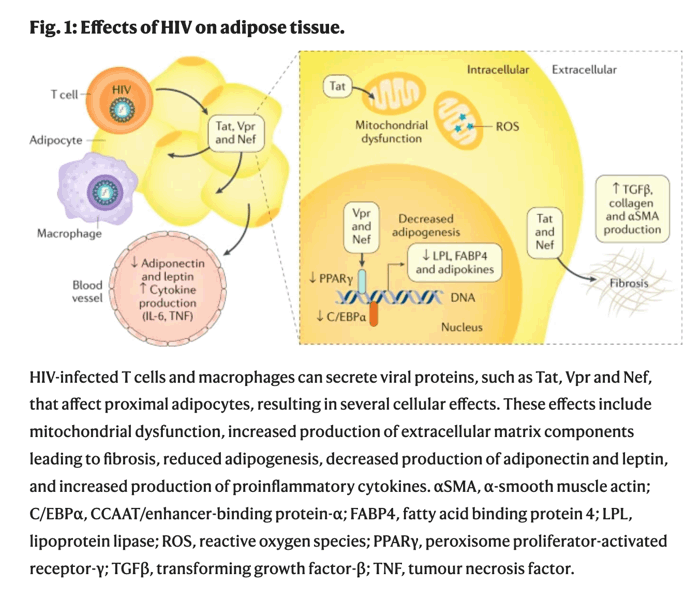| |
HIV and antiretroviral therapy-related fat alterations
|
| |
| |
Download the PDF here
Nature Reviews June 2020 - John R. Koethe1, Claire Lagathu2, Jordan E. Lake3, Pere Domingo4, Alexandra Calmy5, Julian Falutz6, Todd T. Brown7 and Jacqueline Capeau2
Several QOL changes have been reported in PLWH. Indeed, PLWH with viral suppression have reported high levels of fatigue or energy loss, insomnia, sadness or depression, sexual dysfunction, and changes in body appearance, among other symptoms271. Lipoatrophy and lipohypertrophy have been associated with depression in adults as well as in older children and adolescents.
After the advent of effective cART in the mid-to-late 1990s, lipodystrophy was generally considered as an unavoidable adverse effect of life-saving therapies. Of the fat alterations in PLWH, facial lipoatrophy is particularly stigmatizing and is suggestive of the use of anti-HIV drugs.
Notably, the '90-90-90' targets are public health objectives and fail to address the health of PLWH as defined by the WHO as "a state of complete physical, mental and social well-being and not merely the absence of disease or infirmity". Indeed, some individuals argue that there is an urgent need to contend with other challenges, including non-communicable diseases, mental health and HIV-related discrimination, and have proposed a fourth '90' of achieving good health-related QOL (HRQOL) among 90% of those successfully treated for HIV
In the general population, ageing is associated with increases in VAT, losses in SAT and accumulation of fat in ectopic sites. These fat changes are thought to be a major source of inflammation and immune activation and have a similar phenotype to those seen in PLWH. For older (generally >50 years of age) PLWH, these fat changes have been associated with physical frailty and cognitive decline290,291,292, suggesting that reversing fat alterations in older PLWH could also reduce the burden of these ageing-related comorbidities. Based on this hypothesis, trials investigating the effects of tesamorelin (NCT02572323), the GLP1 analogue liraglutide (NCT02743598) and exercise (NCT02663934) on cognitive function in PLWH are ongoing.
Abstract
Early in the HIV epidemic, lipodystrophy, characterized by subcutaneous fat loss (lipoatrophy), with or without central fat accumulation (lipohypertrophy), was recognized as a frequent condition among people living with HIV (PLWH) receiving combination antiretroviral therapy. The subsequent identification of thymidine analogue nucleoside reverse transcriptase inhibitors as the cause of lipoatrophy led to the development of newer antiretroviral agents; however, studies have demonstrated continued abnormalities in fat and/or lipid storage in PLWH treated with newer drugs (including integrase inhibitor-based regimens), with fat gain due to restoration to health in antiretroviral therapy-naive PLWH, which is compounded by the rising rates of obesity. The mechanisms of fat alterations in PLWH are complex, multifactorial and not fully understood, although they are known to result in part from the direct effects of HIV proteins and antiretroviral agents on adipocyte health, genetic factors, increased microbial translocation, changes in the adaptive immune milieu after infection, increased tissue inflammation and accelerated fibrosis. Management includes classical lifestyle alterations with a role for pharmacological therapies and surgery in some patients. Continued fat alterations in PLWH will have an important effect on lifespan, healthspan and quality of life as patients age worldwide, highlighting the need to investigate the critical uncertainties regarding pathophysiology, risk factors and management.
ART initiation and long-term treatment have been almost universally associated with weight and generalized fat gain, particularly in the trunk, leading to abdominal obesity (also known as visceral obesity)8,9. Moreover, integrase strand transfer inhibitors (INSTIs) have been associated with weight gain and generalized fat gain in some PLWH10. The NRTI backbone agents used in these patients can also affect weight gain to varying degrees; TDF has been shown to result in less weight gain than other NRTIs in some studies10,11, whereas tenofovir alafenamide (TAF; a newer formulation of tenofovir) has been associated with greater weight gain than TDF, abacavir or the non-NRTI (NNRTI) efavirenz in trials11,12.
Mechanisms of fat alterations in PLWH are complex and result from the direct effects of HIV proteins and antiretroviral agents on adipocyte health, in addition to changes in microbial translocation and the immune response, increased tissue inflammation and accelerated fibrosis, although these mechanisms are only partly understood. In addition, the effects of HIV and antiretroviral therapies on fat differ between individuals. To this end, a central fat distribution, in particular within the visceral adipose tissue (VAT) depot (an 'apple' shape or android distribution) is generally associated with a less favourable metabolic phenotype, greater inflammation and insulin resistance, and an increased risk of T2DM and cardiovascular diseases13. By contrast, a distribution where the subcutaneous adipose tissue (SAT) depot is preferentially expanded, particularly in the lower extremities ('pear' shape or gynoid distribution), is associated with a more favourable metabolic phenotype and insulin sensitivity13.
Fat alterations remain an issue in patients receiving contemporary cART, compounded by the rising rates of obesity globally, and particularly in North America. This Primer summarizes the characteristics and mechanisms of HIV-related and ART-related fat alterations, focusing on the current cART era, and discusses the management and critical research gaps in the field.


|
|
| |
| |
|
|
|